Have Sticking Doors & Windows? Your Foundation May Be to Blame
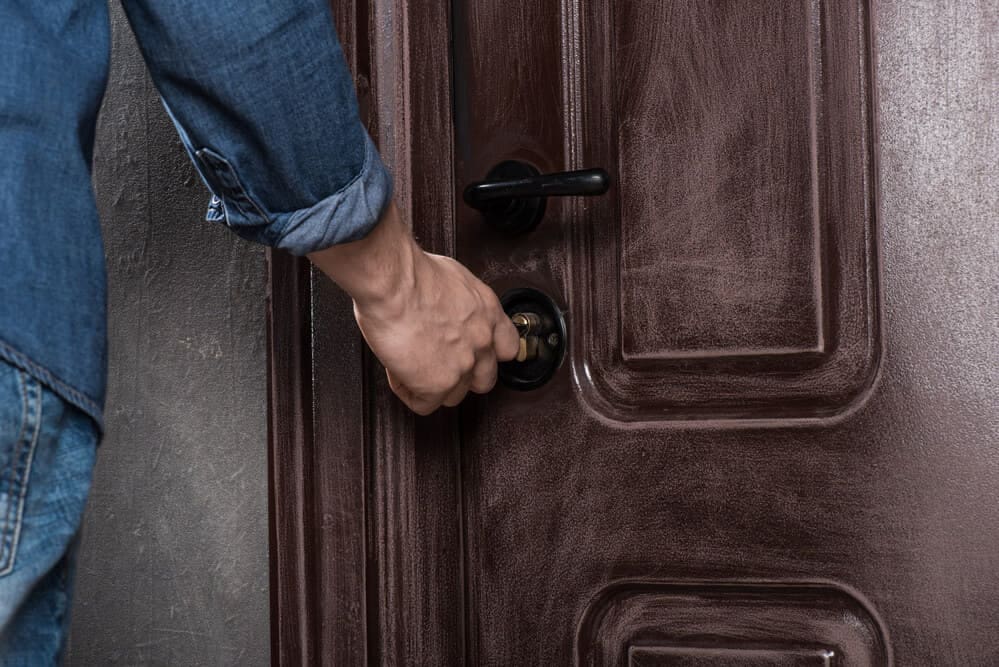
Originally published 8/28/19, updated 10/5/23
Do you have a window or door that doesn’t want to close properly? Or one that you struggle to open? This is often referred to as “sticking,” and it means the door frame and the door no longer line up properly. You may think this is just a part of an aging home, but you’d be mistaken!
Acculevel is a family-owned and operated company that specializes in foundation repairs. Since our start in 1996, we’ve helped tens of thousands of homeowners restore strength and stability to their houses. For most of us, buying a house is the biggest investment a person makes; it’s important to make repairs to maintain your home’s value.
There are two common explanations for why a window or door sticks, and we can help you with both! In this article, we’re going to review both causes, how to diagnose each one, and discuss solutions.
Uncontrolled or Excess Humidity Can Cause Seasonal Sticking
The most common reason you have sticking doors or windows is changing humidity levels. Most interior doors are made of wood, and virtually all door and window openings are framed in lumber. Wood is a porous material, which means it can absorb moisture. So when the humidity levels are higher, wooden doors and frames absorb a bit of the moisture. If they absorb enough, they’ll start to expand.
A slight shift in wood framing is enough to cause a door edge to brush against the frame. It can also make the strike plate to be off-center, which is why the door may no longer latch properly. If the framework shifts closer to the door hinge, the door may close itself, too.
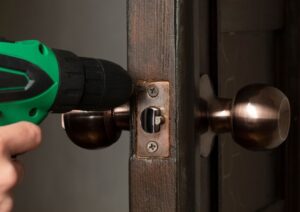
Adjusting the strike plate can sometimes (temporarily) resolve the issue.
DIY Options Are Only Short-Term Solutions
People are naturally inventive, and we’re quick to attempt simple do-it-yourself options. The most common DIY option involves applying a lubricant to the edge of the door or window. The materials we hear most are: moisturizer free soap, petroleum jelly, and candle wax. These are all meant to reduce the friction caused by a sticky door or rubbing window without adding moisture.
More Long-Term Adjustments Can Make Things Worse
If you’re a little more of an advanced DIY fan, you may be tempted to take bigger steps:
- Tighten the hinge screws, or install new door hinges
- Relocate or tighten the strike plate on the door jamb
- Sand the sticking door, the door frame, or even the threshold on the floor
- Shave or sand down the window trim
The above solutions are all likely to fix a sticking door problem for a while, but what happens when the humidity level drops? When there’s not as much moisture in the air, the wood will dry out and shrink. The door or window will be too loose in the framework, possibly with a new gap between the door and the trim. Now you have the opposite problem: a door that fits too loosely in its frame.
Control The Humidity Level In Your Home
The best way to fix a sticking door or window is by eliminating the cause. You can do this by installing a whole-home dehumidifier and regulating the humidity level throughout your home.
We’re not talking about the small dehumidifiers that you buy at a box store. Those have to be emptied frequently and rarely have settings besides high and low.
The AprilAire model we install can remove 12 gallons of water in a day, comes with a water line that runs directly into a sump pump or basement drain, and can be programmed to your preferred humidity level. This will do more than address sticking doors or windows; it will also directly benefit the indoor air quality for you and your family. You can learn more about the benefits and value of a whole-home dehumidifier in this article.
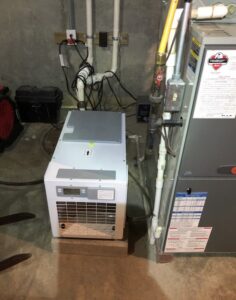
This photo was taken by an Acculevel crew member. The dehumidifier is placed on blocks to ensure the water line will drain down into the sump pump pit.
However, if you already have the humidity in your home well-regulated, it’s time to evaluate the stability of your home’s foundation. That’s because the other major cause of a door that sticks is uneven settling.
How Does Foundation Settling Affect Doors and Windows?
If your foundation is settling evenly, you shouldn’t notice any issues. After all, settling is a natural process: the weight of your house slowly presses itself against the ground and sinks in miniscule amounts. But when nature is involved, there’s an element of unpredictability.
Uneven Settling Is the Issue
Heavy rains can saturate the soil, allowing it to compact more in some areas than others. The rain can also erode the soil under your foundation. The freeze-and-thaw cycle that we experience in Midwestern winters can also play a part, if frost heaves or adfreezing develop.
Drought is another natural force that can cause settling. When the ground around your home dries out, it shrinks away from the foundation. This can “pull” soil from under the foundation, creating an effect similar to erosion.
Settling in your foundation becomes a problem when one section sinks more than the others do. This uneven movement stresses the building materials, which are not flexible. Concrete and drywall will crack under the pressure. The wooden frame of your house will twist or bend under the strain. The combination of these forces is what creates the sticking door and window problems for you.
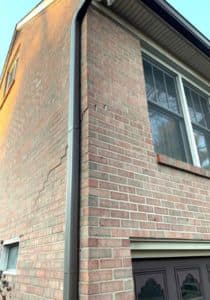
This photo was taken by an Acculevel project advisor during a free home evaluation.
How Do You Detect Uneven Settling
In addition to the sticky door problem you’ve already noticed, there are two other major giveaways:
- Cracks in the drywall. These are usually located in the same room or section of the house where the door is sticking. The cracks should be around the door or window frame and often originate at the corner of the opening. (See photo below)
- Exterior cracks in the foundation itself. Again, these will most likely occur in the same area of the home as your problem door or window. (See photo above for an example.)
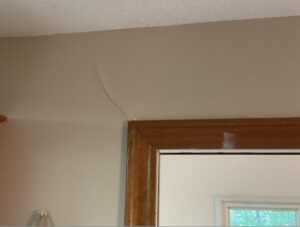
This photo was taken by an Acculevel project advisor during a free home evaluation.
How Do You Repair a Settling Foundation?
You’re going to need a professional contractor for something as significant as uneven settling. A foundation problem like this can have a tremendous impact on your home’s stability; after all, literally everything in your home is resting on that foundation!
All foundation repair experts agree that piers are the best way to stabilize your home’s foundation. Piers are designed to prevent a home from settling any further, and possibly even be able to lift the foundation back towards its earlier position.
There are two types of piers that can be installed: helical and push piers. Acculevel has installed both kinds, but we believe that helical piers are the best and safest choice for residential properties.

This is an illustration of helical piers supporting a foundation.
What Are Helical Piers?
Helical piers are sort like giant screws; they’re steel posts that are driven into the ground until they reach stable, undisturbed soil. Once they’re securely set into the ground, they’re attached to your foundation with brackets.
In some cases, piers can be used to slightly lift the foundation, to “even out” the home. This isn’t always possible. The longer a home has been settling, or the farther into the earth it has sunk, the less likely it will lift. But in ideal conditions — like the home in the picture below — the foundation can be elevated enough to restore functionality to window and door frames.

This photo was taken by an Acculevel crew member during pier installation. This pier is located directly under a door that has a gap forming in one corner.
If your home has a basement or crawl space, helical piers can be used to stabilize and prevent further settling. In some cases, piers are also used for slab foundations. However, slab foundations are often repaired with slab jacking, which is a method of concrete leveling. In some instances, you may even need a combination of piers and slab jacking.
This is why it is so essential that you find an experienced and knowledgeable contractor to assess your foundation. If helical piers are installed incorrectly, or in the wrong location, they are not going to stabilize your home (or fix your sticking doors).
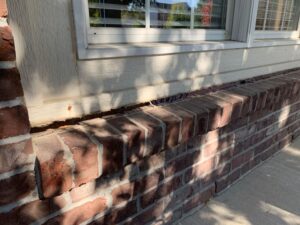
This photo was taken by an Acculevel project advisor during a free home evaluation. You can see the gap forming below the window.
Learn More About Helical Piers
Our learning center offers more resources for you, addressing the questions we are asked most frequently by our customers.
- How do helical piers compare to push piers?
- Do you have an example of using slab jacking and piers?
- How much does pier installation cost?
- What do I need to know before I have piers installed?
Do You Have Sticking Windows or Doors?
If you live in Indiana or in the surrounding states, call Acculevel! We’ll schedule an appointment for you with one of our friendly and knowledgeable project advisors. They’ll evaluate your home, discuss your concerns, and help you decide on the best course of action for you and your family.
Whether you need waterproofing or foundation repair, most of our services include a life-of-structure warranty. Equipment like sump pumps and dehumidifiers come with a 5-year manufacturer’s warranty (which we service for our customers).
Want to know more about us? Check out what our customers say: we have more than 700 reviews on Google with a 4.8 average rating.
Don’t live in our service area? You’ll need to find a foundation repair company that is reputable and experienced with installation helical piers. We recommend that you verify the contractor is insured and accredited with the Better Business Bureau.